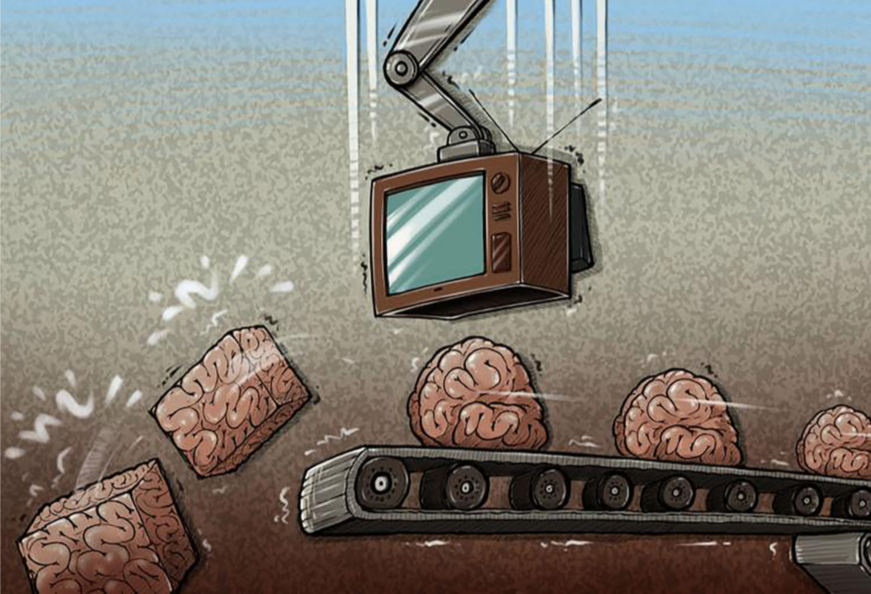We in unison agree that media control people. But we seldom approve that media control us; because we are not able to give up media. Giving up media appears to be giving up our freedoms; but in truth it is media and their masters that hold us sway. We, for better or for worse, are products of media to a great extent. The images that we have of the world, the other, and even of ourselves are a lot from the media.
We sit, in buses and trains, on transits, in office, even on our thrones, scrolling down on our screens. We get influenced, immersed, and lost in the content and form of the mass media. Plato’s 24-century-old allegory of the cave is so very true in the case of the social media today. The allegory portrays people as slavish, naïve receivers like sponges; knowing only as much as they are told, whether it is true or not. Plato underlines that people consider reality to be just the visible world, when reality in truth is more than what meets the eye. His allegory assumes that if a group of prisoners had their necks and hands chained down in a cave; they would be unable to see behind themselves. With a fire behind them, they would be only capable of seeing shadows of images reflected on the cave wall in front of them as they passed by the fire behind them. As time passes, even if the prisoners begin to identify that these are only shadows they are helpless to do anything. And if somehow one of the prisoners could climb out of the mouth of the cave, he would not be able to see anything at first because the light would be so blinding. If the freed prisoner begins to see, and returns back to the cave one day; and tell the other prisoners about the fire behind them and that the shadows they see are not real images, they would not believe him and would accuse him of trying to disrupt their way of life.
The movie The Truman Show (1998), which in many ways, is a modern day adaptation of the Plato’s cave. It too has light/ fire, the shadows, the breaking of the chains, the prisoners, the free prisoner, the cave, etc. Truman was a prisoner in the cave, he only knew what he was being fed to believe, and when he tried to look for the truth, or rather look past what they were telling him, they keep him from knowing the truth. Truman ultimately decides to leave Seahaven Island, where he was trapped in the sets, characters and constructed stories and images of a reality show.
Mass media content, in more ways than one, has become like the shadows of reality appearing on the walls of Plato’s cave, or the constructed realities set up for Truman to live in and live with. Every media content is a constructed reality often for profit, propaganda, and to manufacture consent. Noam Chomsky and Edward S Herman would explore further the people, factors, and filters behind and are at play in what becomes news or media content today. Ownership by large corporations or conglomerates to maximise profit sacrifices objectivity and truth. Advertisers are kept happy by not putting out anything that would conflict with the ‘buying mood’ of the population. Media firms sell readers and viewers as products to advertisers. There is an Indian lore that says, the mouse dies in the mousetrap because it does not understand why the cheese is free. If it is free, you are the product. Media firms spend far less to obtain credible content from trustworthy sources; and play safe so as not to gather negative press and public opinion. News firms find it easy when they have a powerful-political or otherwise-friend to work for. Friends’ enemy becomes media firm’s enemy too.
On the other hand, when we consumers use media to gratify our specific wants and needs, often very privately, media algorithms, for profit and other gains, show us content based on what they think would gratify us. This process can lead to the creation of a filter bubble. They don’t show us things that are uncomfortable or challenging or important. These filter bubbles are one-sided; they show us the side, we want to see; they tunnel down our point of view and isolate us from each other.
The documentary The Social Dilemma by Netflix features interviews with former employees from today’s largest social media platforms. The film tells us that many social media companies succeed by capturing as much of our attention as they can, then they sell that attention to the highest bidders. According to Tim Wu, the author of the book The Attention Merchants, says that it is a business model that sells access to people’s minds. The attention industry needs people who are in a distracted state, or who are perpetually distractible, and thus open to advertising and other less important things. We end up spending hours of the day clicking on random nothingness.
The Social Dilemma suggests that it is important in this age of fake news and misinformation to question everything that we read online. Be critical of situations in which beliefs and narratives are amplified or reinforced by communication and repetition inside a closed system, namely, an echo chamber, and insulated from rebuttal and dissent. Beware of priming: media’s way of positioning certain content as more important than others, and framing: packaging of a media content with rhetoric and narrative that would encourage certain interpretations.
Written as TOGETHER editorial.

Comments
Post a Comment